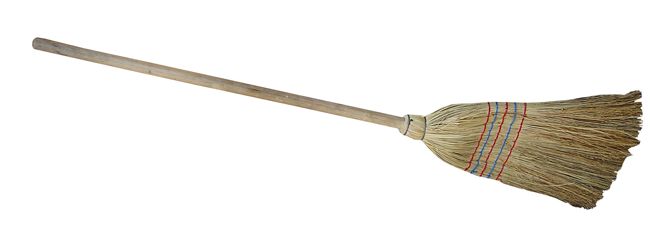
Let me start with a quick story. I went to a local bar with a few friends recently. After consuming more brews than is probably healthy, I headed home. Walking up the path to the house, I was greeted by the wife standing at the door with a broom in her hand. “Cleaning up or going somewhere?” I asked. It didn’t end well.
Now that I've shown how brooms can get you into trouble, let me discuss how broomsticks can get you out of trouble as a trainer.
The three key ways that I use broomsticks are helping clients understand what a neutral spine feel likes and how it needs to be maintained during lifts, assisting with flexibility and mobility, and assisting with postural assessments.
Proper spinal alignment when lifting is critical to preventing injuries, both to yourself and your client. Ensuring that the head and back are in the appropriate position and that the spine is arched in the appropriate places will protect clients when squatting, deadlifting, and performing any standing or overhead exercises.
While verbal cues such as “flat back,” “arch hard,” or “neutral spine” are an important part of instructing clients, the ability to demonstrate this position to them and how to hold it helps to increase their level of understanding. Enter the humble broomstick. By placing a broomstick along the client’s spinal column, you allow him to feel what the correct postural position feels like. For me, this involves having the back of their head and the spine between the shoulder blades and the tailbone area all in contact with the broomstick. Only these points should be in contact with the broomstick.
Once the client has learned the static application of the correct spinal position, it can be extended to movements, particularly for those clients who lose spinal alignment. The broomstick can move with the client during a squat, deadlift, or overhead press (with you holding it of course) to ensure that the three points of contact and spinal neutrality are maintained. This should initially be done without a weight and bar on the clients back and built up as he adjusts to the movement.
Using the broomstick to maintain spinal alignment can also help to identify other problem areas for the client as he seeks to compensate for deficiencies. Hip flexor, hamstring, or spinal flexibility issues may become apparent as the client seeks to maintain the correct posture, and these can be actively addressed.
I also make extensive use of the broomstick for floor based exercises such as push-ups and bird dogs. With push-ups (and planks), the stick is used in the same way. This is of most benefit to clients who tend to lead with their head when doing push-ups. The broomstick helps teach them to keep their head back and allows them to lead with their chest. When doing bird dogs, the keys are the same. The extra challenge presented to the client is to maintain appropriate stability to ensure the broomstick doesn't roll off as he completes the exercise.
Using a broomstick to loosen the shoulders is a fairly common stretch, particularly for some of the mirror exercisers (you know them...these are the guys who focus on the chest, biceps, abs, and quadriceps—the muscles you can see in a mirror). Broomstick shoulder dislocations, if you follow the training style of this tribe, is all that is required prior to completing set after set of the bench press.
While this is a valid use of the broomstick, there are others. Mike Robertson identifies a great pectoral stretch that utilizes the broomstick. To see it amaze clients the first time they do it is an understatement. It is a great variation on the standard doorway stretch.
The broomstick can also be used effectively to help mobilize the thoracic spine through rotations. Again, visit Mike Robertson’s website (www.robertsontrainingsystems.com) for details on how to do this correctly. (Along with EliteFTS, I rate this as a must visit site, one that I recommend to all the new trainers at our facility and those who are studying to be trainers.)
I also make some use of the broomstick when completing postural assessments. Having the client place the broomstick on the back of the shoulders and checking the ends of the broom for differences in height can help to identify imbalances. I also have the client hold the broomstick at his side to check the spinal and postural alignment from a side-on position.
I have also used the broomstick to convince clients that they can squat. I recently had a client insist that due to back and other injuries, he couldn’t complete a squat. I gave him the broomstick, asked him to place it across his shoulders, break his hips, bend his knees, and see how far he could get down. After some verbal cueing, some further demonstrations, and use of the broomstick to confirm spinal alignment, he was able to complete a squat to slightly above parallel. Not bad for someone who was convinced he couldn’t squat at all without some form of Armageddon being unleashed on his body. Further remedial work on his tight hip flexors has him to the point where he now can squat to parallel.
The broomstick is nothing more than a tool that can be used effectively in the training of clients. Learn how best to use it, add it to your toolkit, and use it to the benefit of your clients. Be wary of upsetting the good lady wife along the way, but be sure to add this tool to your repertoire. If there are other uses of the humble broomstick that I have overlooked, please let me know.








